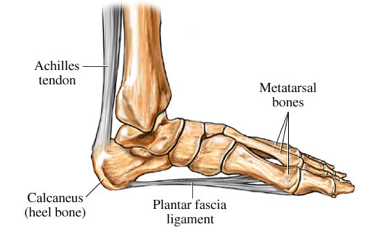PLANTAR FASCIITIS
 The plantar fascia is a tight band of tissue that runs from your heel to the ball of your foot. This band pulls on the heel bone and raises the arch of your foot as it pushes off the ground. Because there is a tremendous load on the fascia every time the foot hits the ground whether running, walking, jumping, skipping, etc, the plantar fascia can become strained. This can cause swelling, fraying of the plantar fascia and ultimately pain (called plantar fasciitis).
The plantar fascia is a tight band of tissue that runs from your heel to the ball of your foot. This band pulls on the heel bone and raises the arch of your foot as it pushes off the ground. Because there is a tremendous load on the fascia every time the foot hits the ground whether running, walking, jumping, skipping, etc, the plantar fascia can become strained. This can cause swelling, fraying of the plantar fascia and ultimately pain (called plantar fasciitis).
Plantar fasciitis is often associated with heel spurs. Heel spurs are extra bone deposited at the site where the fascia attaches to the heel bone. This is a very common body response to stress. However, it is usually the tearing of the plantar fascia that causes pain, not the bone spur.
TREATMENT OPTIONS
Plantar fasciitis can take months to reduce the symptoms and pain and surgery is rarely required.
I recommend starting with the least invasive treatment modalities.
1) Nonsteroidal anti-inflammatory drugs (NSAIDs). NSAIDs, such as ketoprofen, ibuprofen (Advil, Motrin, others) and naproxen (Aleve), may ease pain and inflammation.
2) Exercises at home and at physical therapy to stretch and strengthen the lower leg muscles.
3) Arch support – start with less expensive over the counter arch supports such as superfeet.
4) Night splints - One of the symptoms of plantar fasciitis is sharp pain in the heel when getting out of bed in the morning. When feet are pointed when sleeping or sitting for long periods of time, the plantar fascia is shortened. Those first steps in the morning or rising from a chair are painful because the fascia is then stretched and torn as the foot is loaded with your body weight. Night Splints are designed to provide a gentle stretch to the plantar fascia and Achilles tendon. This gentle stretch helps reduce the muscle contracture, inflammation, and associated heel pain, and helps promote healing of plantar fasciitis.
5) Corticosteroids – and injection with a steroid/cortisone to the area may also help reduce pain and inflammation and allow the plantar fascia to heal. However, not all patients get full relief from this and the injection can be quite painful.
6) Surgery – some patients that fail months of nonsurgical treatment may require surgery.
To find out more information on Plantar Fasciitis, please visit the Orthopaedic connection website of American Academy of Orthopaedic Surgeons.



 The plantar fascia is a tight band of tissue that runs from your heel to the ball of your foot. This band pulls on the heel bone and raises the arch of your foot as it pushes off the ground. Because there is a tremendous load on the fascia every time the foot hits the ground whether running, walking, jumping, skipping, etc, the plantar fascia can become strained. This can cause swelling, fraying of the plantar fascia and ultimately pain (called plantar fasciitis).
The plantar fascia is a tight band of tissue that runs from your heel to the ball of your foot. This band pulls on the heel bone and raises the arch of your foot as it pushes off the ground. Because there is a tremendous load on the fascia every time the foot hits the ground whether running, walking, jumping, skipping, etc, the plantar fascia can become strained. This can cause swelling, fraying of the plantar fascia and ultimately pain (called plantar fasciitis).